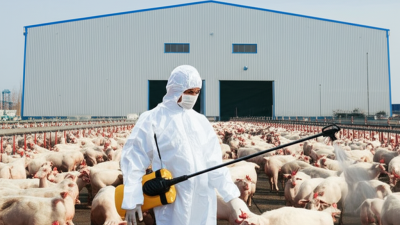Choosing the right vet disinfectant is crucial for maintaining the health and safety of animals and preventing the spread of infectious diseases in veterinary practices. According to a report by the American Animal Hospital Association, over 70% of veterinary hospitals have reported incidents of zoonotic disease transmission, highlighting the importance of effective sanitation measures. A proper vet disinfectant not only helps in eliminating pathogens but also minimizes the risk of antibiotic resistance, which is a growing concern in veterinary medicine. Furthermore, the World Organization for Animal Health emphasizes that regular disinfection is a key component in infection control protocols. With a variety of products available on the market, understanding the essential criteria for selecting the most appropriate vet disinfectant is fundamental for veterinary professionals committed to ensuring a safe environment for their patients and staff.

When selecting a vet disinfectant, understanding the importance of EPA certification is crucial. The Environmental Protection Agency (EPA) sets standards for disinfectants to ensure they are effective in killing pathogens while being safe for both animals and the environment. Disinfectants that carry the EPA certification have undergone rigorous testing and evaluation, making them a reliable choice for veterinary practices. This certification indicates that the product not only meets safety standards but also has proven efficacy against a broad spectrum of microorganisms, which is essential for maintaining a sterile environment in veterinary settings.
Moreover, using EPA-certified disinfectants can help ensure compliance with health regulations in veterinary care. Facilities that utilize these products demonstrate a commitment to the highest hygiene standards, which is vital for preventing outbreaks of infectious diseases. Additionally, choosing a product with clear EPA registration provides peace of mind for pet owners, as it reflects a facility's dedication to safeguarding animal health. In summary, focusing on EPA certification when choosing a vet disinfectant is fundamental to ensuring both effectiveness and safety in veterinary practices.
When selecting a vet disinfectant, it's crucial to evaluate its effectiveness through key metrics that ensure a safe and healthy environment for both animals and staff. One of the primary metrics to consider is the disinfectant's broad-spectrum efficacy. Disinfectants must be effective against a wide range of pathogens, including bacteria, viruses, fungi, and spores. Identifying products that have been tested against specific pathogens commonly found in veterinary settings can greatly enhance infection control efforts.
Another important factor is the contact time required for the disinfectant to effectively eliminate microorganisms. Different surfaces and types of contamination may require varying contact times, so it's essential to choose a product that aligns with the facility's workflow and operational needs. Additionally, the residual activity of the disinfectant can play a significant role in maintaining hygiene between regular cleaning cycles. Disinfectants that continue to work effectively after application can provide an added layer of protection against recontamination, making them a valuable choice for busy veterinary practices.
 When selecting a vet disinfectant, understanding its safety and toxicity is paramount. Many disinfectants, while effective in eradicating pathogens, may pose risks to animals and staff due to their residual effects. It's crucial to choose products that are specifically formulated to minimize toxicity. Always check the ingredient list; opt for disinfectants that utilize environmentally friendly and non-toxic components. This will not only protect the health of animals but also safeguard the well-being of your team.
When selecting a vet disinfectant, understanding its safety and toxicity is paramount. Many disinfectants, while effective in eradicating pathogens, may pose risks to animals and staff due to their residual effects. It's crucial to choose products that are specifically formulated to minimize toxicity. Always check the ingredient list; opt for disinfectants that utilize environmentally friendly and non-toxic components. This will not only protect the health of animals but also safeguard the well-being of your team.
Additionally, consider the contact time required for the disinfectant to be effective. Shorter contact times can help reduce residual exposure, making it safer for animals and staff alike. Regularly re-evaluating your products based on user reviews and safety data can provide insight into any potential issues related to toxicity or environmental impact. Keeping an eye on the latest veterinary recommendations will aid in selecting a product that strikes the right balance between efficacy and safety, ensuring a healthy environment for all.
When selecting a vet disinfectant, cost-effectiveness analysis plays a crucial role in maintaining a balance between budget constraints and disinfectant efficacy. Veterinary practices often operate within tight financial limits, making it essential to assess the long-term value of a disinfectant rather than just its initial purchase price. An effective disinfectant should not only eliminate pathogens but also demonstrate durability, requiring fewer applications and ultimately reducing ongoing costs.
Moreover, understanding the specific needs of a veterinary facility can lead to smarter purchasing decisions. Choosing a disinfectant with a proven track record of efficacy against a broad spectrum of pathogens may incur a higher upfront cost, but the reduction in disease transmission and subsequent veterinary care can justify the expense. Facilities should also consider factors like safety for both animals and staff, compatibility with equipment, and ease of use, as these elements contribute to overall efficiency and effectiveness in maintaining a clean environment. Balancing these aspects within the scope of a budget allows veterinary practices to achieve optimal health outcomes for their patients while maintaining financial viability.

When selecting disinfectants for various surfaces within a veterinary clinic, it is essential to consider compatibility with the specific materials used throughout the facility. Different surfaces such as stainless steel, glass, and plastic require tailored disinfectant solutions to ensure efficacy and prevent damage. According to a report by the American Animal Hospital Association (AAHA), using incompatible products can lead to surface degradation and possible chemical reactions that compromise disinfection efforts.
Tip: Always check the manufacturer's recommendations for both the surface material and the disinfectant. For example, quaternary ammonium compounds (quats) may be effective on hard surfaces but can be less stable on porous materials. It is critical to use a disinfectant that is validated for efficacy against common veterinary pathogens, such as Canine Parvovirus, as per data from the Centers for Disease Control and Prevention (CDC), which has been increasingly scrutinized due to the rising prevalence of infectious diseases within animal populations.
Tip: Conduct regular evaluations of your clinic’s disinfectant regimen. A study by the Journal of Veterinary Internal Medicine emphasizes that routine monitoring of disinfectant effectiveness ensures that your clinic remains compliant with health standards and reduces the likelihood of outbreaks. Implementing an effective protocol not only safeguards the health of animals but also supports the overall operational integrity of a veterinary practice.
| Surface Type | Recommended Disinfectant | Compatibility Notes | Contact Time |
|---|---|---|---|
| Exam Tables | Quaternary Ammonium Compounds | Safe for most surfaces, non-corrosive | 10 minutes |
| Kennels | Bleach Solutions | Effective but may corrode metal surfaces | 5-10 minutes |
| Floors | Hydrogen Peroxide | Non-corrosive, good for most materials | 10 minutes |
| Grooming Areas | Vinegar Solutions | Natural, safe for sensitive areas | 5-15 minutes |
| Waiting Rooms | Alcohol-Based Disinfectants | Rapid evaporation, safe for electronic devices | 3-5 minutes |






